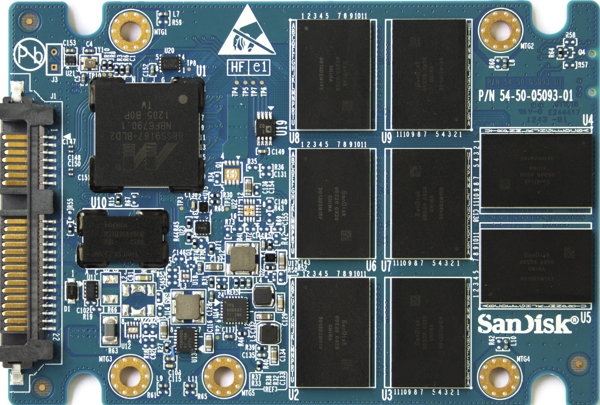SanDisk Extreme II SSD Review: Striking At The Heavy-Hitters
SanDisk is looking for a rise to prominence in the SSD segment with a new Marvell 88SS9187-based drive. The Extreme II packs 19 nm Toggle-mode NAND (from SanDisk, naturally), specialized firmware, and intriguing performance potential. How does it compare?
A Guided Tour Of SanDisk's Extreme II
Taking the Extreme II apart is easy. Four screws hide behind the label, and the plastic top half falls away from the metal chassis down below. A series of thermal pads mate PCB components to the metal housing for improved heat transfer. These pads cover the DRAM cache, Marvell's controller, and the eight NAND packages. It's like silly putty in a way; it tends to pull the screen printing off of component ICs, making them harder to decipher in photographs.
The 240 GB PCB you see here may not completely reflect the final product. What shouldn't change, however, are the eight quad-die packages of 19 nm ABL eX2 Toggle-mode NAND, adding up to 256 GB of capacity. The Toggle-mode interface eliminates the clock signal needed by synchronous flash, theoretically lowering power consumption. We've seen similar power characteristics from the 19 nm flash manufactured by Toshiba and SanDisk, though older Toggle-mode-based SSDs tended to use more power than competing drives with ONFi-compliant memory.
Marvell's '9187 controller is flanked by 256 MB of Hynix DDR3 DRAM. We like to see a ratio of DRAM to NAND running 1 MB for every gigabyte of flash on-board, so it makes sense that this 240 GB Extreme II has 256 GB riding shotgun. The 120 GB hosts 128 MB of cache, while the 480 GB model sports 512 MB.
The PCB's back side is bare, aside from some solder points.
Get Tom's Hardware's best news and in-depth reviews, straight to your inbox.
Current page: A Guided Tour Of SanDisk's Extreme II
Prev Page Extreme II, The Sequel From SanDisk Next Page Test Setup And Benchmarks-
Someone Somewhere Where's the 840/840 Pro?Reply
Also, you appear to have put one of the labels back on the wrong way round. -
boulbox I have always been a fan of Sandisk SSDs, can't wait until to try this out in someone else's build as they usually sell their products that is very acceptable for budgets.Reply -
slomo4sho I am also curious about the selection of the comparative models. Having the Extreme (not II) in the charts for comparison between the two generations would have been a welcomed addition along with the inclusion of the 840 series.Reply -
flong777 I know a lot of people have already pointed this out but can't Tom's Hardware afford a damn 256 GB 840 Pro? I mean come on, it is the fastest SSD on the planet right now.Reply -
raidtarded Seriously, what is the point of this article? The fastest car in the world is as Yugo if you dont test against a Lamborghini.Reply -
teh_gerbil Why are there 2 of your most recent SSD reviews lack the Samsung 840/Pro? Are you being paid by the respective companies to avoid using them, as for both SSD's, as per other reviews I have read, the 840 Pro cr@ps all over both of them, but due to your lack of them, they're both top of your benchmarks! Very very bad benchmarking.Reply
http://www.tomshardware.com/reviews/vertex-450-256gb-review,3517.html -
merikafyeah Want an 840 Pro comparison and far more in-depth review?Reply
See here: http://www.anandtech.com/show/7006/sandisk-extreme-ii-review-480gb
It's Anand's new favorite SSD, and based on the results, I'm inclined to agree.
It's peak performance is right up there with the 840 Pro, but what's really extreme is the drive's consistency. It's performance when the drive is close to full is unmatched.
There are no high peaks accompanied by low valleys in performance when it comes to the Extreme II. It's pretty much smooth and fast sailing all the time, which in my book, places the Extreme II a step above the 840 Pro. The 840 Pro would have to be at least $30 cheaper than the Extreme II for me to even consider it over the Extreme II.
-
JPNpower Why is the 840 Pro the fastest SSD on the planet? It has its share of drawbacks, and is slower than the OCZ Vector, and the Plextor M5 Pro Xtreme on many benchmarks. Don't make broad statemets that aren't always true.Reply


